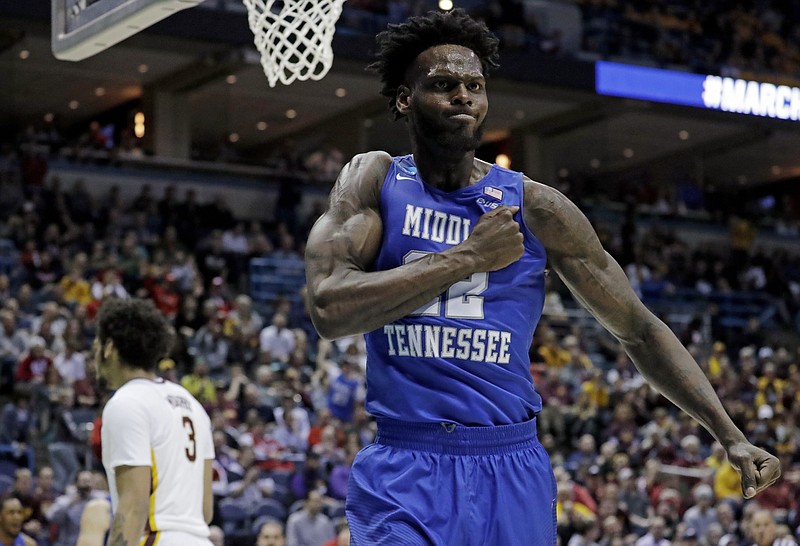When Middle Tennessee State University announced late last week that it was signing longtime basketball coach Kermit Davis to a new seven-year contract, the school's news release contained an interesting quote from athletic director Chris Massaro.
Perhaps hoping to make his boosters fully aware of the financial commitment it normally takes to build a mid-major basketball team capable of reaching the round of 32 in consecutive NCAA men's tournaments - as the Blue Raiders just did - Massaro said:
"If we want to have a big-time basketball program with a national brand, then we need a more robust Blue Raider Athletic Association and we have to fill Murphy Center. When you look at programs we benchmark, like Wichita State, VCU and Butler, those are things that separate us. We had an attendance increase this past season and we appreciate the growth, but we need an even deeper commitment."

As this 2017 NCAA tourney nears its completion with only four schools still around to compete for its title, there is little doubt that money talks.
Even Gonzaga - the lone non-Power Five conference school in a Final Four that also includes North Carolina, Oregon and South Carolina - has an annual operating budget of nearly $7.4 million, which is similar to that of the Tar Heels ($7.5 million) and more than the Ducks ($6.8 million) or Gamecocks ($6.82 million).
Given that the only other non-Power Five conference school among the Sweet 16 participants was Butler, which is believed to have an annual budget of around $4.5 million, it's easy to conclude that making a significant run during March Madness is no cheap trick.
Especially at the University of Tennessee at Chattanooga's level ($1.74 million) or MTSU's slightly better neighborhood of $2.5 million.
"The gap (between the haves and have-nots) is starting to widen some," UTC athletic director David Blackburn said Monday. "Revenue sharing and television contracts are going to continue to create an even bigger divide."
Some would look at the current financial struggles at ESPN and the alternate internet options available for free and surmise that most schools would be wise to plan to make do with less in the coming years.
Blackburn believes that could be toughest on those "Next Five" conference schools such as Big East member Butler, because those conferences are caught in the middle as they attempt to provide a taste of true major college basketball at a lower cost.
"They're trying to keep up with wants as well as needs," Blackburn said. "We're just concerned about need at our level. Are we providing proper medical care? Do we have enough academic support personnel? Things like that."
It does make you wonder where all this is headed. Yes, it's been an enjoyable tournament with some stupendous finishes - Xavier-Arizona, Kentucky-North Carolina, Michigan-Oregon, to name only three - but look more closely at those who advanced. Fourteen of the final 16 were high majors. The round of 32 was 23 to 9, and three of those so-called mid-majors were Butler, Virginia Commonwealth and Wichita State, which all have reached at least one Final Four since 2011 and have budgets of $4.6 to $5.72 million.
This isn't to say you absolutely, positively can't make a run to the Sweet 16 on financial fumes. UTC proved as much 20 years ago. But the odds of that sort of repeat are worsening rather than improving, though MTSU and Davis certainly challenged that theory with a respectable loss to Butler in the round of 32 after shocking Minnesota in the round of 64.
And to reward such fine work, Massaro raised Davis from a $465,000 base annually to go along with $100,000 for radio and television work to a new pact that starts at $575,000 in addition to a $175,000 media deal.
To show how much value MTSU and Massaro are putting on the Blue Raiders' back-to-back round-of-32 finishes, Davis' base salary for the 2015-16 season was $375,000.
That's almost certainly the reason the release offered this Massaro quote: "I also want to thank a number of our donors who stepped up and contributed to make this possible."
If this is the cost of winning on a national level, given that Mocs basketball coach Matt McCall makes $232,000, UTC clearly has a ways to go.
"Fans do have to buy in," Blackburn said. "The money doesn't just show up from the state. But if you don't win, it doesn't work."
Davis has been winning for most of his 15 seasons in Murfreesboro. His record at MTSU is 307-180 (.630). Over the past six seasons he stands 154-54 (.740) with three NCAA tourney appearances. Whatever Davis and Massaro are doing is working.
Yet with the Mocs reaching the NCAA tourney a season ago for the first time since 2009, Blackburn believes "we're getting there."
Still, in light of this year's dearth of true long shots such as UTC in this year's tourney, it might behoove all the little guys who dream of reaching the Big Dance to soak in these words from Massaro: "We are trying to increase our national brand, and to do this we have to have commitment. The university has upped their commitment, Coach Davis is committed and now we ask our fans, donors and alums to up their commitment."
In other words, hoops dreamers, put your money where your mouths are or commit to sentencing your school to watch March Madness from afar.
Contact Mark Wiedmer at mwiedmer@timesfreepress.com.
